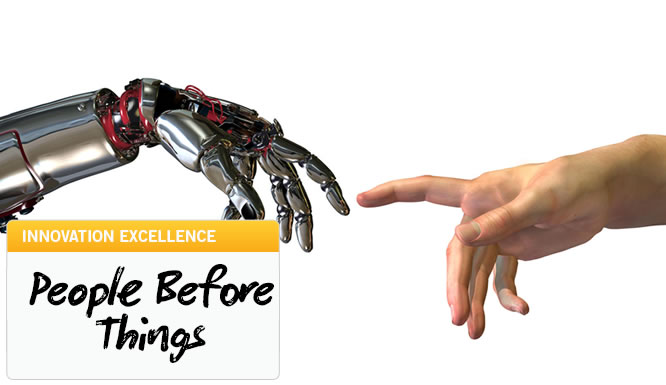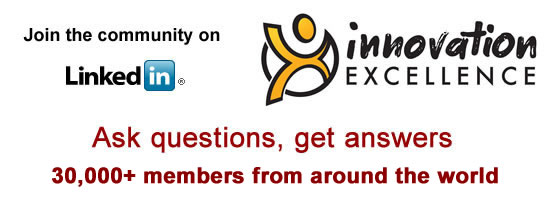Why Only Adoption Matters

An Interview with Chris Laping, author of People Before Things
Recently I had an opportunity to interview Chris Laping, the former Chief Information Officer (CIO) for the Red Robin restaurant chain about some of the challenges in achieving successful organizational change. Chris’ is a voice that emerged from the darkness as I was creating the Change Planning Toolkitâ„¢ and conducting the research for my latest book Charting Change (focused on helping people beat the 70% change failure rate).
Chris Laping is a kindred soul sitting at the intersection between people, process and technology and working to clear the resulting cloud of confusion that results. Unable to convince Chris to join the chorus of hand-picked guest expert voices in my book, I’m super happy to have the privilege of sharing this conversation with Chris Laping about his new book People Before Things to give you a glimpse of the inner workings of an experienced, talented, and insightful change leader mind.
What follows is a series of questions and answers designed to give you a peek into his thinking and the insights contained in his new book.
1. One of the first things you talk about in the book is failure. Why is this?
I used to work with an executive who often used the expression, “Failure is not an option.” I always thought it was wrong on a couple of levels. First, I don’t believe failure is the opposite of success. Rather, it’s an important step in achieving success. Second, people don’t choose to fail so using magic-wand management to just remind them not to fail isn’t effective. Strong leaders realize that they have to take ownership for all the conditions needed for their teams to succeed. When the English poet and writer G.K Chesterton was asked by the London Times, “What’s wrong with the world today,” his response was, “Dear sir, I am.” If I asked leaders what’s wrong in their organizations today, I would hope to hear, “Dear sir, I am.”
2. How do you define Change Leadership, and what matters most for leaders of change to be successful?
In my executive career, I really came to understand that change isn’t an end-user problem. What I mean by that is there are tactics used to encourage adoption which disproportionately put the burden of success on the shoulders of the people being impacted by the change. As an example, we often use communications and training to ensure compliance with a new standard. And when people don’t comply, we give them more communications and training. It’s kind of like, “The beatings will continue until morale improves.” But to me, change leadership is about ensuring the right conditions are in place to ensure success. As an example, if people don’t have the time of day to absorb something new, then Capacity gets in the way of adoption. A change leader understands that and makes accommodations for the needed time. That’s a much different mindset than expecting that team members will just use discretionary effort to learn something new.
 3. What is your view on the role of design in change and why is it important?
3. What is your view on the role of design in change and why is it important?
Just like Capacity, Design is one of those conditions that change leaders know will greatly impact adoption. As an example, one of my favorite restaurants has stenciled a painted sign above the toilets that reads, “Please place lid down when finished to activate automatic flush.” Instead of acknowledging the design defect (because after all, it’s not automatic if you have to do something to activate), they’ve chosen to train every team member and guest on how to use the toilet. That’s a perfect example of disproportionately putting the burden on end-users. Over the years I’ve learned that this kind of thing happens because leaders check-out during the Design process. When this happens, complexity ensues as project team members try to mediate what should and shouldn’t be included. And complexity is the great enemy of success.
4. Sometimes people view simplicity with suspicion and choose complexity instead. When it comes to change, is it better to keep things simple or strive to be comprehensive in your approach?
One of the conditions I encourage leaders to focus on is Alignment, but with a twist. Instead of talking about goals and vision and WHAT needs to be accomplished, it’s important to align a team to WHY we’re doing something. As a former CIO, I saw many systems that grew in complexity because we weren’t using the WHY as the North Star. Instead, we were only focused on the WHAT. As an example, if you lead a project team that is implementing an HR system (the WHAT), there are tons of different definitions of what that is and what it includes. It results in the team mediating and prioritizing thousands of requirements. However, if you lead a project team with the notion that we are implementing a system that helps us grow and develop our team members (the WHY), it hones in on the exact requirements needed to be successful.
5. For the benefit of the audience, what is the theory of optimization and how does it relate to change?
It’s a simple math theory that I use with leaders to demonstrate the condition of Capacity and how it influences change. It takes something leaders see as soft and squishy and makes it hard and tangible. The theory of optimization basically says one thing will come at the cost of another. There is a inter-related technique called linear programming, which is used to find the best solution with limited resources to maximize profit or minimize cost. The key to both points is when you manipulate one variable it changes the impact of other variables. This isn’t an assumption, it is MATH! Yet, when allocating their people’s time to work efforts, leaders often ignore it. Even though they know their teams are already working on a priority, they add another priority and this significantly affects success and change adoption.
6. As you see it, what are the states of change that people must move through in any successful change effort?
I think there are three simple reasons most people don’t cooperate with a change effort. First, they don’t have any awareness or know about the change. This often-times results from a cascading process that went wrong. Sometimes, people do have awareness, but they don’t have the understanding or requisite skills to be successful. Team members aren’t always forthcoming when they don’t know how to do something so leaders really have to pay attention to this. Finally, sometimes people do have awareness and they actually do understand the new change, but ultimately, they don’t have preference or care about the change. In my view, change leaders have to use an approach that achieves the outcomes of awareness, understanding and preference. And again, I think there are conditions that leaders control that accelerate this process.
 7. Many people see communications as the most important part of a change effort, what tips do you have for them?
7. Many people see communications as the most important part of a change effort, what tips do you have for them?
Communications is great for awareness but not so much for achieving understanding and preference. As an example, if you’re trying to achieve buy-in (preference) through fancy messaging, it comes across like a disingenuous campaign promise. So my first piece of advice around communications is to recognize its limitations and not overuse it. (Many leaders do this.) Second, communications is more effective when it comes from an “important voice.” When team members hear messages, they often respond better when it comes from someone who is their boss or someone they perceive as important. And who they perceive as important changes with every message. As an example, executives should provide the messaging when the vision or WHY of a change is being shared. However, when it comes to details about how and when things will be accomplished, team members may really want to hear from project leaders who are closer to the effort. The key is that a one-size-fits-all approach rarely works.
8. I noticed in the book that you also encouraged people to leverage some of marketing’s toolbox in their change efforts. Which tools from marketing do you think are most relevant and impactful for change efforts?
When I talk about awareness, understanding and preference, that comes from a basic marketing model itself. Marketing teams use a concert of tactics that seek those outcomes with their customers. If we apply that same approach to internal stakeholders and use a concert of tactics, we don’t have to reinvent the wheel. Very briefly, I believe the condition of Communications can be used to build awareness (and nothing more). The condition of Learning can improve understanding. (But there is more to this than just the old-school training mindset.) Finally the conditions of Stakeholder Engagement (listening to stakeholders and taking demonstrable action on their feedback) and Support (high-touch, empathetic response) builds preference. The most important point in all of this is that Change Leadership is more than just speaking loudly, which is what leaders are doing when they 100% rely on communications to push change.
9. Finally, there is increasing chatter out there about customer experience, what are your thoughts on the connection between branding and care?
Every company I’ve ever worked with has a goal of customer loyalty–they just want their customers to love them. However, their customers will never love them if their team members don’t love them first. And I believe that if their team members only like them, they will only earn customers who like them. Finally, if their team members hate them, I promise that they’ll upset customers who will stop being customers. How leaders treat their team members when something big changes at work absolutely influences whether they will love their company. So my advice to leaders is that instead of purely focusing on the customer, they will realize tremendous benefit by focusing on their team members first.
Conclusion
Thanks Chris! For a great practitioner narrative on principles of successful change leadership I hope readers will check out his new book on change, and if you want to grab some tools and a deeper perspective on successfully planning change check out mine. The two go well together. People Before Things is currently the #2 new release for Organizational Change on Amazon and is an easy read. I came away with several useful takeaways from reading it, and I think you will too.
Image source: blog.timesunion.com
Wait! Before you go…
Choose how you want the latest innovation content delivered to you:
- Daily — RSS Feed — Email — Twitter — Facebook — Linkedin Today
- Weekly — Email Newsletter — Free Magazine — Linkedin Group
 Braden Kelley is a popular innovation speaker, builds sustainable innovation cultures, and tools for creating successful change. He is the author of the five-star book Stoking Your Innovation Bonfire and the creator of the revolutionary new Change Planning Toolkitâ„¢. Follow him on Twitter (@innovate) and Linkedin.
Braden Kelley is a popular innovation speaker, builds sustainable innovation cultures, and tools for creating successful change. He is the author of the five-star book Stoking Your Innovation Bonfire and the creator of the revolutionary new Change Planning Toolkitâ„¢. Follow him on Twitter (@innovate) and Linkedin.
NEVER MISS ANOTHER NEWSLETTER!
LATEST BLOGS
The Importance of Packaging
Let’s talk about packaging. Packaging can be thought about in many different ways, but if we think purely about the purpose of packaging first, we find the purpose is to: contain the product, communicate product information, …
Read MoreWhy the World Cup is a Big Deal
After living overseas in Germany and England and now coming back to the United States, I have a completely different perspective on Football (or Soccer as we call it in the United States). With the World Cup in full swing, I thought I would tackle the subject of Football and why it is the most popular sport in the world.
Read More



